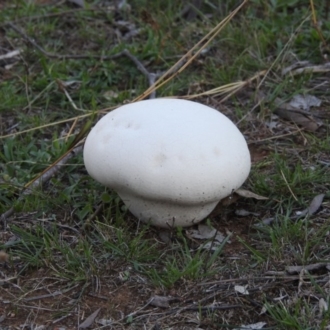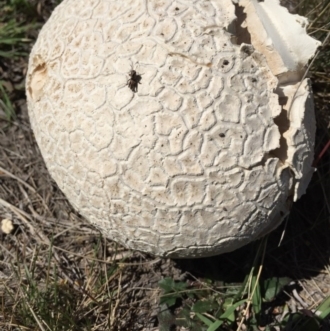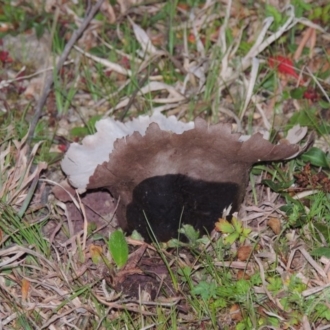Calvatia sp. (a puffball )
Calvatia fruit bodies are globose to pear-shaped and from a few centimetres to a half metre in diameter. There is a thin skin (less than a millimetre thick) within which, at maturity, there is a mass of powdery spores held within what looks like a mass of cotton-wool (technically called a capillitium). Spores are brown to purple and at maturity the outer surface may be white, greyish, various shades of brown or purplish.
The skin breaks irregularly and pieces falls away to expose the spore-filled capillitium. Over time wind removes both spores and capillitium.
In many species (especially those with more or less pear-shaped fruit bodies) there is a well-developed spore-free, sterile base. That sterile base is spongy and remains after all the spores and capillitium have disappeared. In some species the sterile base is very rudimentary.
Species of Calvatia are found in a variety of habitats but are very common in grasslands or open woodlands.
Calvatia vs. Scleroderma
Scleroderma is another genus in which you may find powdery spored, roughly globular fruit bodies in which the outer skin breaks up.
In Scleroderma the skin is thick, breaks more or less radially and the segments bend out to expose the powdery spores. The segments stay intact and fragments of skin do not fall away.
In Scleroderma there is no capillitium.
Calvatia sp. is listed in the following regions:
Canberra & Southern Tablelands | South Coast
Species information
- Calvatia sp. Scientific name
- a puffball Common name
- Not Sensitive
- Local native
- Non-invasive or negligible
- Up to 1185m Recorded at altitude
- Machine learning
Location information
-
Maps
Bluetts Block (402, 403, 12, 11) Budjan Galindji (Franklin Grassland) Reserve Bullen Range Denman Prospect 2 Estate Deferred Area (Block 12) Farrer Ridge Gibraltar Pines Goulburn Mulwaree Council Illilanga & Baroona Isaacs Ridge and Nearby Kowen Woodland Mawson Ponds Melrose Micalong Gorge Mount Ainslie Mount Majura Mount Taylor Mulligans Flat Namadgi National Park Nimmitabel Meatworks TSR Red Hill to Yarralumla Creek Sherwood Forest The Fair, Watson The Pinnacle Umbagong District Park Urambi Hills Wanniassa Hill -
Places
Gunning, NSW Isaacs, ACT Kambah, ACT


































































































